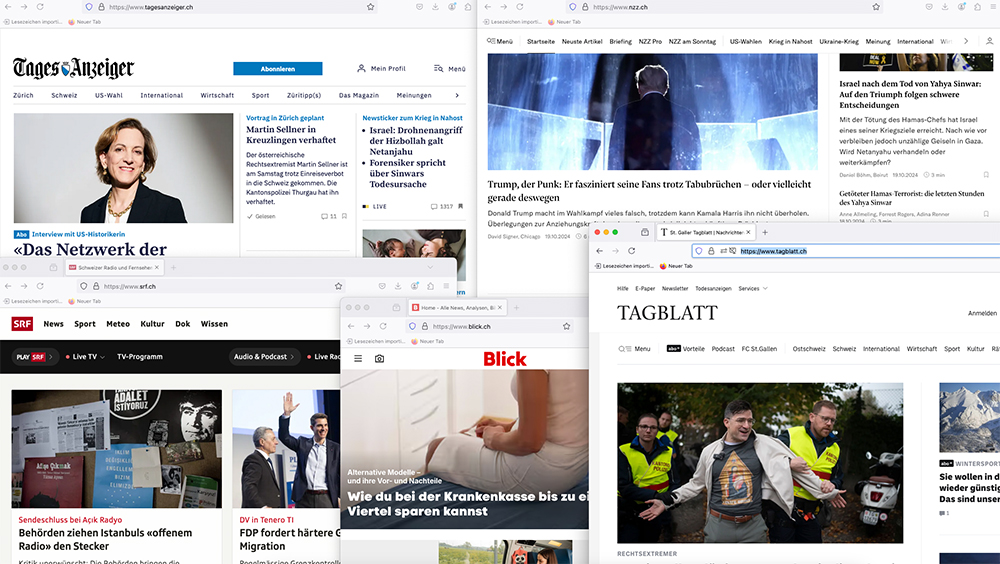Navigation auf uzh.ch
Navigation auf uzh.ch

Public media are often accused of sidelining, or even “crowding out”, private media in the news market. With numerous online news media now competing for attention and for paying subscribers, this crowding-out argument is gaining prominence. In this year’s edition of the Yearbook Quality of the Media, fög examined this crowding out argument using data from a standardized, representative survey that the University of Oxford had conducted in German-speaking and French-speaking Switzerland as part of the Reuters Institute Digital News Report 2024.
Analysis of the data reveals that SRG users consume subscription media offline and online (61%) more frequently than those who do not use SRG news (38%). Not only that, but the proportion of SRG users consuming commuter and tabloid media across multiple channels (75%) is also higher than for non-users (58%).
“Thus, the majority of the Swiss population does not use news from SRF and RTS exclusively; rather, they rely on them to supplement those of private news media,” explains Mark Eisenegger, Director of fög. This also applies to the online sector, with only around 4% of all respondents consuming SRG online news exclusively. This figure is significantly lower than the proportion of respondents who make exclusive use of commuter and tabloid media (26%) or subscription media (8%) online.
The study did not find a statistical link between people’s use of certain types of media and people’s willingness to pay. “Whether or not people pay for online news depends more on the their attitudes and socio-demographic characteristics,” says Eisenegger. “Men and younger people are more likely to pay. And those with a strong interest in news and politics tend to be more willing to spend money on digital news.”
Another study in the Yearbook reveals that the population remains sceptical about the use of artificial intelligence (AI) in journalism – at a time when Swiss media companies have already started using AI in many areas. Almost three quarters of people in Switzerland consider AI in journalism to be high risk, a larger proportion than in other areas of society such as politics or the military. In this context, it can be stated that the more AI intervenes directly in journalistic output – such as text or image production – the higher the level of scepticism. By contrast, the majority do support the use of AI for translation, data analysis or research. Many respondents expect transparency from the media regarding the use of AI and would like to see detailed disclosure of all articles and work steps that have involved the use of AI. Only a minority of respondents (21%) believe that Swiss media are handling AI responsibly.
Additional long-term analyses in the Yearbook reveal that the quality of many Swiss media outlets remains good overall, even though it has declined slightly compared to the previous year. “Swiss media outlets do not have a quality problem but a reach problem, with an increasing number of Swiss people consuming little or no news at all,” Eisenegger notes. The proportion of the news-deprived, i.e. people not getting enough news, stood at 46% in 2024 (+3 percentage points compared to the previous year).
In addition, the financial situation in journalism remains tense. One consequence of this is the increasing concentration of media content, i.e. the recycling of news items. Regional reporting had largely managed to escape this phenomenon but now, for the first time, instances of recycling in various media have increased sharply compared to the previous year. Given the often limited availability of up-to-date information at regional and local level, any further loss of diversity will be problematic.
The analyses in the 2024 Yearbook show just how much pressure journalism is facing because of digital transformation and the decline in traditional revenue sources. However, the belief that there is mainly a rivalry between private and public news media is proving to be unfounded. “The pressure on Swiss news media mainly comes from outside, namely from global tech platforms, which absorb a large proportion of online advertising revenues,” explains Eisenegger. “In light of this, cooperation between private and public media should be expanded.” This could shore up the Swiss media system’s position vis-à-vis tech platforms – and, more recently, AI providers – and promote the development of innovations that benefit the entire industry.
The Yearbook Quality of the Media 2024 and the in-depth studies are available here:Yearbook Quality of the Media 2024 (in German) (PDF, 2 MB)
Main Findings (PDF, 642 KB)